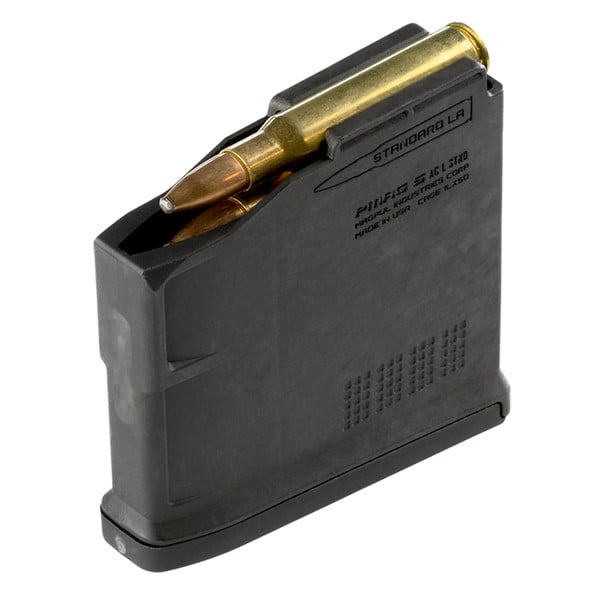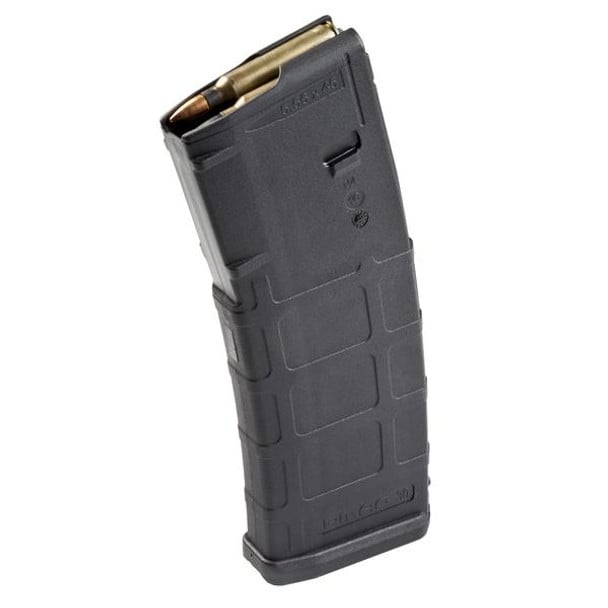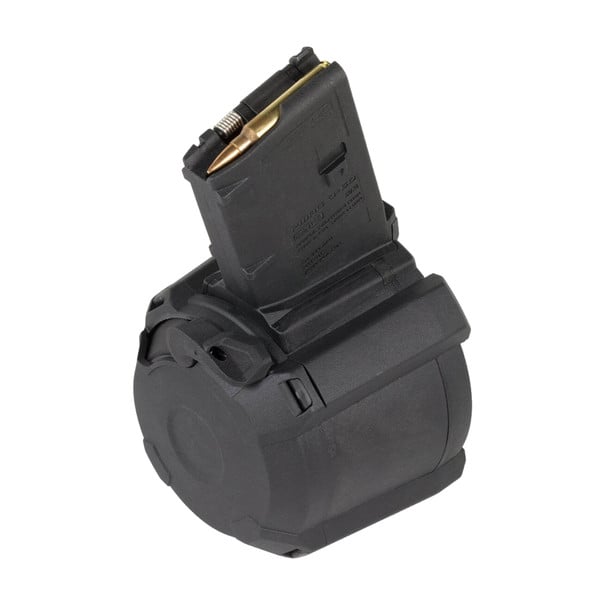Rifle Magazine Variants: Choosing the Right Capacity & Material
We made this quick guide to rifle magazines for all beginner rifle owners wondering what the capacity is right for their shooting activity and how to choose a good magazine that will serve a long time. Let’s get started.
Common Rifle Magazine Capacities
Low-Capacity Magazines (5-10 Rounds)

Low-capacity magazines, holding between five to ten rounds, are often chosen for hunting and target shooting where precision and accuracy matter more than sending a lot of rounds downrange. Some states have specific rules on magazine capacity for hunting to keep things safe and support conservation efforts. For instance, in Colorado, hunters using semiautomatic rifles for big game are limited to 6 rounds in the magazine and chamber combined. Low-capacity magazines are also used in jurisdictions with strict magazine capacity laws, such as California.
Benefits
- Easier to handle and lighter.
- Often comply with hunting regulations.
- Suitable for beginners focusing on accuracy.
Downsides:
- Limited firing capacity, requiring more frequent reloading.
- Not ideal for high-intensity shooting sports where rapid fire is needed.
Standard-Capacity Magazines (20-30 Rounds)

Standard-capacity magazines usually hold between 20 to 30 rounds, depending on the caliber. This capacity is common in many modern sporting rifles, such as the AR-15, AR-10, AK-47, etc., and is popular for a variety of uses, including home defense, tactical applications, and practical shooting competitions, such as 3-Gun.
Benefits:
- Balanced weight for maneuverability.
- Adequate for most recreational shooting activities.
- Widely available and commonly used.
Downsides:
- May not be compliant with legal restrictions in certain states or regions.
High-Capacity Magazines (50+ Rounds)

High-capacity drum magazines can hold 50 or more rounds. Basically, drum mags are used in situations where sustained fire is necessary, such as practical shooting competitions, or simply for having fewer reloads when plinking at the range.
Benefits:
- Less frequent reloading.
- Ideal for competitions requiring high-volume fire.
Downsides:
- Heavier and bulkier, making the firearm less maneuverable.
- Can be prone to feeding issues and malfunctions.
- Often subject to stricter legal regulations and bans in many jurisdictions.
Factors Influencing Capacity Choice
When selecting the right rifle magazine capacity for your needs, consider the following factors:
Type of Shooting
Hunting

Many states limit rifle magazine capacities to promote responsible hunting. The thing is that lower capacities mean fewer shots in quick succession, encouraging deliberate and accurate shots. This ensures humane harvesting, reducing the risk of wounding animals unnecessarily.
- Manual action (bolt, lever, etc.): These rifles have 3 to 5 rounds of capacity, which can be increased with an aftermarket detachable magazine though.
- Semi-automatic rifles: Vary in capacity, but states often limit them to 5 rounds for hunting due to the design’s natural capacity to shoot fast. Typically, those wishing to hunt with a semi-auto rifle need a 5-round magazine. However, there are states with milder regulations, i.e. Texas imposing no capacity restrictions except shotguns for migratory game birds.
Target Shooting, Competitions & Plinking

In dynamic shooting, standard-capacity box magazines (20-30 rounds) are often preferred over drum magazines due to being easier to handle and reload. Plus, they are lighter and maintain the firearm's balance, making shooting more steady. However, in some scenarios, the higher capacity of drum magazines might outweigh the benefits of box mags.
For precision shooting, opt for lower-capacity magazines (5-10 rounds). A shorter magazine makes it easier to position the rifle on the bench rest, giving you a steadier platform for accurate shots.
Home Defense
For home defense, many people prefer standard-capacity magazines, around 20-30 rounds. This capacity gives you enough ammo to feel secure without making the firearm too heavy or bulky. Think of it like having a good balance – enough rounds to stay safe but still easy to handle.
Legal Regulations and Restrictions
Magazine capacity regulations vary widely across US states. One of the strictest examples is California.It's illegal to buy, sell, manufacture, import, or transfer magazines holding more than 10 rounds. This applies to all firearms—rifles, shotguns, and handguns. The law aims to reduce mass shooting potential by limiting the ammunition a shooter can fire without reloading. Violators face severe penalties, including fines and potential imprisonment. Some exceptions exist for law enforcement officers and certain competitive shooters with special permits. However, the general public must adhere to the 10-round limit.
While California's regulations are among the strictest, several other states also have capacity restrictions:
- Connecticut, District of Columbia, Illinois, Hawaii, Maryland, Massachusetts, New Jersey, New York, Rhode Island, Washington: 10 rounds
- Colorado, Vermont: 15 rounds
- Delaware: 17 rounds
- Virginia: 20 rounds
Always check local regulations so you stay within the law and avoid any legal trouble.
Other Considerations
- Weight and Maneuverability: More rounds mean more weight. A magazine packed with 50 rounds will be heavier, making your firearm harder to carry and maneuver.
- Reliability: Drum magazines holding 50+ rounds can sometimes have feeding issues, meaning they might not be as reliable under certain conditions.
Common Materials Used in Rifle Magazines
Polymer Magazines
They are lightweight, making them easy to carry during long hunting trips or range sessions. They are also corrosion-resistant and more affordable than metal options. However, they can be prone to cracking under extreme conditions and may warp under high temperatures during rapid firing.
Aluminum & Steel Magazines
Metal magazines offer impressive strength, withstanding substantial impact and rough handling. They also excel in heat resistance. However, one significant drawback is that any feeding lips issues are less apparent. Plus, metal mags are more expensive.
Hybrid Magazines
Hybrid mags combine a plastic body with metal feed lips.
Which One Is Right for Me?
Actually, polymer seems to be the best material for an average shooter because it’s light and cheap. If you face extreme conditions, metal or hybrid magazines might work better. But generally, modern magazines are made from high-grade polymers, matching metal mag’s durability.
Besides body and feeding lips material, look for an anti-tilt follower feature and a stainless steel mag spring.
The Best Rifle Magazines
Magpul Rifle Magazines (Polymer)
Features:
- High-grade polymer
- Aggressive grid-pattern texturing
- High-tension stainless steel spring
- 4-way self-lubricating anti-tilt follower
- Dot matrix for marking loads
AR-15 Capacities: 10, 10/30, 20, 30, 40, 60
Platforms: AR-15, AR-10, AK, CZ Scorpion EVO 3, HK MP5, bolt-action rifles (.223 Rem, .308 Win, .300 Win Mag, .30-06 Sprg)
Hexmag Rifle Magazines (Polymer)
Features:
- PolyHex2 advanced composite for superior toughness
- Hexagonal pattern
- Heat-treated stainless-steel spring
- Colorful follower and latch place for identification
- Tool-less design
AR-15 Capacities: 10, 10/30, 15, 20, 30
Platforms: AR-15, AR-10
ETS Magazines (Clear Polymer)
Features:
- Translucent body
- Advanced clear polymer resistant to impacts, harsh temperature fluctuations, UV, and chemicals
- No-creep feed lips
- Bigger over-insert tab
- Anti-tilt follower
- Tool-less design
- Grip ribs
AR-15 Capacities: 30
Platforms: AR-15, HK MP5, CZ EVO, CZ Scorpion EVO
Lancer Magazines (Hybrid)
Features:
- Steel feed lips
- Durable polymer body
- Aggressive texturing
- Available in many colors, including translucent
- Anti-tilt follower
- Stainless steel spring
AR-15 Capacities: 10, 20, 30
Platforms: 5.56/223: M4/M16/AR15, SCAR16, HK416, ARX160, SIG556, ARC, SIG MCX, IWI Tavor, IWI X95, SA80; .308/6.5 CM: SR-25, DPMS AR-10, SIG 716, LMT, LM308, POF P308, and S&W M&P-10
ASC Magazines (Metal)
Features:
- Stainless steel or aluminum body
- Self-lubricating coating
- Anti-tilt polymer follower
- Chrome silicon springs for resilience in high temperatures
AR-15 Capacities: 5, 10, 20, 30
Platforms: AR-15 (in various calibers), AR-10
FAQs
What factors should I consider when choosing a rifle magazine?
When choosing a rifle magazine, consider the following factors:
- Capacity: The number of rounds the magazine can hold.
- Material: Options include polymer, aluminum, and steel, each with different weights, durability, and costs.
- Intended Use: Different activities like hunting, target shooting, and tactical uses might require different capacities and materials.
- Legal Regulations: Local laws can impose restrictions on magazine capacity.
How often should I clean and inspect my rifle magazines?
Regular cleaning and inspection are crucial for maintaining the performance and longevity of your rifle magazines. It's recommended to clean and inspect them after every shooting session, especially if you've been using them in harsh environments. This helps to prevent misfeeds, jams, and other issues.
Can I use any type of magazine with my rifle?
No, not all magazines are compatible with every rifle. It's crucial to ensure that the magazine you're purchasing is designed for your specific rifle model and caliber to ensure proper fit and function.
Are metal magazines more durable than polymer magazines?
Metal magazines, such as those made from steel or aluminum, are generally more durable than polymer magazines. However, polymer magazines are lighter and often more cost-effective. Plus, many brands now use reinforced, high-grade polymers, which durability matches that of the metal. The best choice depends on your specific needs and preferences.
Can I modify my magazine to hold more rounds?
Modifying your magazine to hold more rounds is generally not recommended and could be illegal depending on your local regulations. Such modifications can also affect the reliability and safety of your firearm, leading to potential malfunctions.
Recent Posts
-
Echelon 4.0C Launch and Its Impact on Handgun Design
Recently, Springfield released the new Echelon 4.0C (aka Echelon Compact) 9mm pistol. Read to lear …Dec 18th 2024 -
The End of an Era: Why Cheaper Than Dirt Stopped Selling Guns
Recently, Cheaper Than Dirt, a major online gun store based in Fort Worth, made headlines by steppin …Oct 24th 2024 -
A Guide to Hunting, Sporting & AR-15 Rifle Barrels
In this post, we’re discussing rifle barrel types in terms of materials, finishes, profiles, twis …Jun 11th 2024




